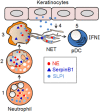Inhibitors of Serine Proteases in Regulating the Production and Function of Neutrophil Extracellular Traps
- PMID: 27446090
- PMCID: PMC4928128
- DOI: 10.3389/fimmu.2016.00261
Inhibitors of Serine Proteases in Regulating the Production and Function of Neutrophil Extracellular Traps
Abstract
Neutrophil extracellular traps (NETs), DNA webs released into the extracellular environment by activated neutrophils, are thought to play a key role in the entrapment and eradication of microbes. However, NETs are highly cytotoxic and a likely source of autoantigens, suggesting that NET release is tightly regulated. NET formation involves the activity of neutrophil elastase (NE), which cleaves histones, leading to chromatin decondensation. We and others have recently demonstrated that inhibitors of NE, such as secretory leukocyte protease inhibitor (SLPI) and SerpinB1, restrict NET production in vitro and in vivo. SLPI was also identified as a NET component in the lesional skin of patients suffering from the autoinflammatory skin disease psoriasis. SLPI-competent NET-like structures (a mixture of SLPI with neutrophil DNA and NE) stimulated the synthesis of interferon type I (IFNI) in plasmacytoid dendritic cells (pDCs) in vitro. pDCs uniquely respond to viral or microbial DNA/RNA but also to nucleic acids of "self" origin with the production of IFNI. Although IFNIs are critical in activating the antiviral/antimicrobial functions of many cells, IFNIs also play a role in inducing autoimmunity. Thus, NETs decorated by SLPI may regulate skin immunity through enhancing IFNI production in pDCs. Here, we review key aspects of how SLPI and SerpinB1 can control NET production and immunogenic function.
Keywords: SLPI; neutrophil elastase; neutrophil extracellular traps; plasmacytoid dendritic cells; psoriasis; serpin B1.
Figures

Similar articles
-
Secretory leukocyte proteinase inhibitor-competent DNA deposits are potent stimulators of plasmacytoid dendritic cells: implication for psoriasis.J Immunol. 2012 Aug 15;189(4):1611-7. doi: 10.4049/jimmunol.1103293. Epub 2012 Jul 11. J Immunol. 2012. PMID: 22786767
-
The inhibitory effect of secretory leukocyte protease inhibitor (SLPI) on formation of neutrophil extracellular traps.J Leukoc Biol. 2015 Jul;98(1):99-106. doi: 10.1189/jlb.4AB1114-543R. Epub 2015 Apr 27. J Leukoc Biol. 2015. PMID: 25917460 Free PMC article.
-
DNA structures decorated with cathepsin G/secretory leukocyte proteinase inhibitor stimulate IFNI production by plasmacytoid dendritic cells.Am J Clin Exp Immunol. 2013 Jun 15;2(2):186-94. Print 2013. Am J Clin Exp Immunol. 2013. PMID: 23885335 Free PMC article.
-
Age is the work of art? Impact of neutrophil and organism age on neutrophil extracellular trap formation.Cell Tissue Res. 2018 Mar;371(3):473-488. doi: 10.1007/s00441-017-2751-4. Epub 2017 Dec 18. Cell Tissue Res. 2018. PMID: 29250748 Free PMC article. Review.
-
Neutrophil Extracellular Traps in Periodontitis: A Web of Intrigue.J Dent Res. 2016 Jan;95(1):26-34. doi: 10.1177/0022034515609097. Epub 2015 Oct 6. J Dent Res. 2016. PMID: 26442948 Review.
Cited by
-
The interplay between serine proteases and caspase-1 regulates the autophagy-mediated secretion of Interleukin-1 beta in human neutrophils.Front Immunol. 2022 Aug 25;13:832306. doi: 10.3389/fimmu.2022.832306. eCollection 2022. Front Immunol. 2022. PMID: 36091026 Free PMC article.
-
Serine protease inhibitor derived from Trichinella spiralis (TsSERP) inhibits neutrophil elastase and impairs human neutrophil functions.Front Cell Infect Microbiol. 2022 Oct 25;12:919835. doi: 10.3389/fcimb.2022.919835. eCollection 2022. Front Cell Infect Microbiol. 2022. PMID: 36389172 Free PMC article.
-
Functional Ambivalence of Dendritic Cells: Tolerogenicity and Immunogenicity.Int J Mol Sci. 2021 Apr 23;22(9):4430. doi: 10.3390/ijms22094430. Int J Mol Sci. 2021. PMID: 33922658 Free PMC article. Review.
-
Targeting Neutrophil Extracellular Traps in Gouty Arthritis: Insights into Pathogenesis and Therapeutic Potential.J Inflamm Res. 2024 Mar 19;17:1735-1763. doi: 10.2147/JIR.S460333. eCollection 2024. J Inflamm Res. 2024. PMID: 38523684 Free PMC article. Review.
-
The recombinant plant Bauhinia bauhinioides elastase inhibitor reduces rat thrombus without alterations in hemostatic parameters.Sci Rep. 2021 Jun 29;11(1):13475. doi: 10.1038/s41598-021-92745-4. Sci Rep. 2021. PMID: 34188079 Free PMC article.
References
-
- Cichy J, Zabel BA. Proteinase regulators of plasmacytoid dendritic cell trafficking and function in psoriasis. In: Carrasco JA, editor. Psoriasis: Causes, Diagnosis and Treatment. New York: Nova Science Publishers, Inc. (2011). p. 137–57.
Publication types
LinkOut - more resources
Full Text Sources
Other Literature Sources
Miscellaneous

